
How should I Be Painting New Plaster?
I often get emails from DIYers and inexperienced people asking me questions, and how do I paint new plaster is a plastering question I get asked frequently. I figured that this is a subject I would cover here on Plasterers News, so I can now direct the questions to this page from this day forwards. How do I paint fresh plaster is a question that gets asked a lot on lots of forums all over the internet, and it has been asked numerous times on The Plasterers Forum as well. So I am pretty sure that this post is going to be very popular and helpful.
When I was on the tools full time (a long time ago now), I used to have a little postcard-sized “how to” sheet that I would give to my customers at the end of the job, and for me, this was another way for them to get my number and a lot of the time this card would end up on the fridge and act as another flyer for their friends and family to have when they needed a plasterer.
On this card, I would explain painting new plaster, and also I used to have a name and contact details of a painter I used to use. This painter was a great painter (had to be to get over my work), and every time he got work off that postcard, I would get a nice kickback, so it was a win-win situation for everybody.
As with running any business, you need to stay one step ahead of the game, and using this painting new plaster postcard would win me more work and kept the painter busy. However, not only that, it was a great way to build a reputation that is still very much intact to this very day. Going that extra step makes people remember you, and that is where the repeat business comes from, and all plasterers know repeat business is where the money is.
So How Do You Paint New Plaster?
One of the common suggestions and I will go as far as to say myths, is that the walls need to be pva’d before you paint them…
I don’t recommend this and have never in all my years seen this being done!! So I would not recommend it at all. You may need to lightly sand the walls before you start painting to give the paint something to key into as some plasterers over polish the walls, and the paint slides around the plaster and does not soak in, but make sure that your walls are clean and free from dust as the paint will stick to the dust and not the plaster.
In the photo below, this is what plaster looks like before it is properly dry…
You don’t want to be painting new plaster until it is fully dried.
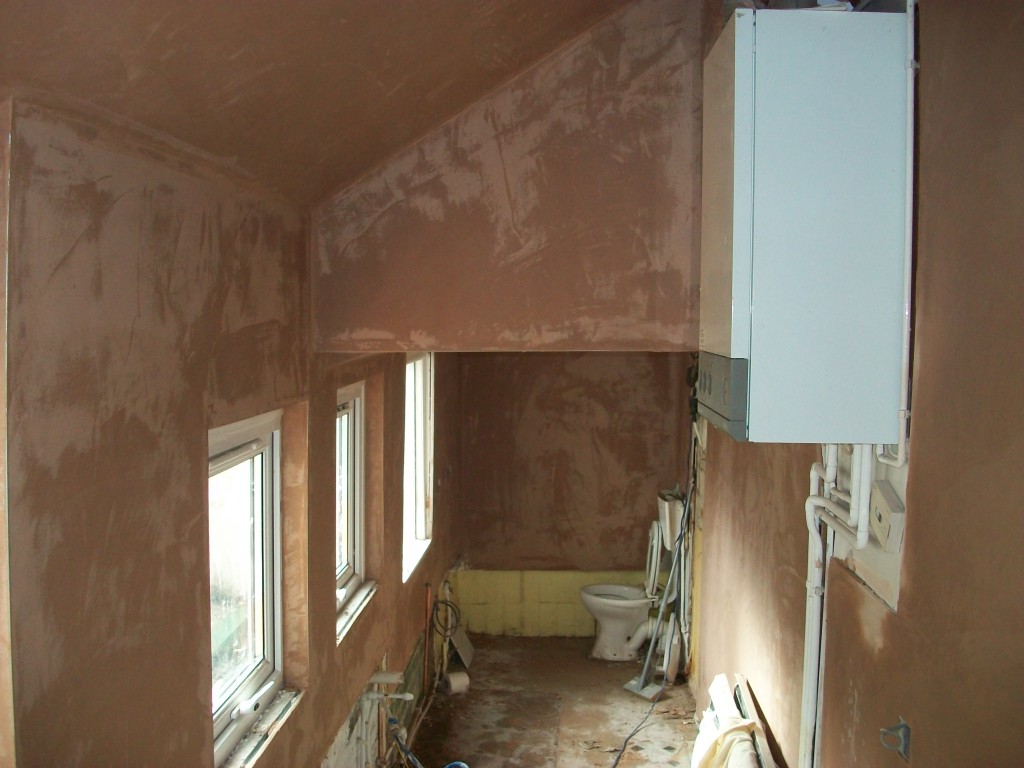
A properly finished plastered wall should be a matt finish and not shine…
Plaster is ready to paint when it has all dried out and gone a light pink colour.
Most of the time, within a couple of days, it is good to paint and waiting for the newly plastered wall or ceiling to be completely dry. This is if the plaster used was British Gypsums Multi Finish, some plasters are white, but you can clearly see when plaster is dry. Furthermore, the drying time can vary from property to property depending on the substrate’s suction or whether the property has any drafts or heating on.
Painting over wet plaster is not a good idea, and although people do it, I would never recommend it and the only time you should paint on newly plastered walls or ceilings is when it is totally dry.
How To Make a Mist Coat Paint
The first coat of emulsion paint you put on any fresh plaster should be what is known as a mist coat, and this mist coat is to highlight any blemishes or misses in the plaster. Once this mist coat has been applied, you can go filling and sanding anything that stands out and needs putting right.
At this mist coat stage, I like to get as bright a light as possible shining all over the walls or ceilings to highlight any blemishes. This is more preparation, but I do it to make sure I am totally happy with how it looks under these intense light conditions. This is one of the best ways to get a near-perfect finish that gives you the professional finish look you will be after.
The photo below shows a wall drying out, and the light parts of the wall are the colour that it is when the new plaster is dry, and the dark patches are damp patches that will need more time to dry out properly. Depending on the conditions, plaster takes anything from a couple of days to a week or two to dry out.
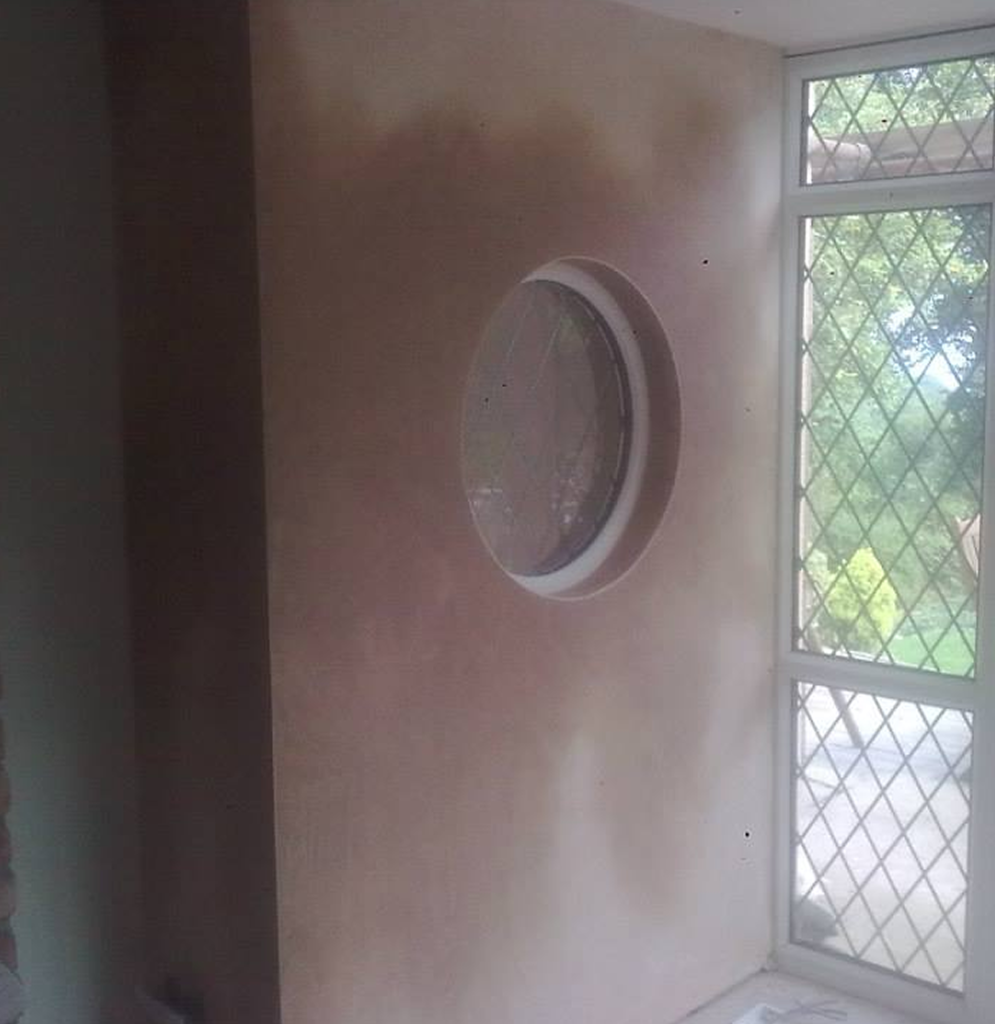
The mist coat is usually the cheapest watered down emulsion paint you can find, and then you water that white emulsion paint down a bit. The amount you water this paint down to varies, but I like to do a 1 to 1 mix as this is what has worked best for me, but other painters recommend adding 10% water to the emulsion paint.
The mist coat is there to seal the plaster, and the added water controls the suction of the wall. If you don’t add any water, the paint won’t absorb into the plastered surface, which will likely cause the paint to peel in the future.
You can also buy bare plaster paint from the likes Screwfix or amazon, and this is already pre-mixed and is perfect for a mist coat and an ideal paint for a freshly plastered wall.
This miss coat then gets rolled onto the wall like you would be painting anything else. Make sure that you roll out any lines and whatnot, as the dry plaster will pull the moisture out of the paint and will dry very quickly, and any lines left in the paint will need sanding.
The mist coat being diluted paint gets drawn into the wall and, in essence, seals the wall. If you use undiluted paint, the moisture will get drawn out quickly, and the paint would sit on top of the plaster rather than become part of the plaster if that makes sense. You may have seen in the past paint just peeling off walls in big sheets, and it looks like fresh plaster underneath, and nine times out of ten, this is because the plaster was painted without a mist coat.
I never recommend using one coat paints as I find the extra coats of paint on a wall or ceiling, the better it looks. All these one coat products never, in my opinion, get the high-quality finish I am after, and in the end, if you are spending all that money getting things plastered, you may as well go that extra mile and finish them to a high standard.
Preparation, Preparation, Preparation is The Key
I enjoy painting new plaster, but I have a little OCD when it comes to finishing, and I like everything to be perfect, and any imperfections are sorted out at the mist coat stage. I hate seeing blemishes in painted walls, and some of the plastering I have seen in my time needs an excellent painter to straighten them out. Spend your time getting this right, and you will have a first-class finish, and you won’t be lying in bed staring at a slight mark in your ceiling that will drive you crazy.
If you have any questions about painting new plaster, then please head over to www.plasterersforum.com for more information and advice.
Thanks to Riviera Plastering for letting us use their photos on this page about painting new plaster.


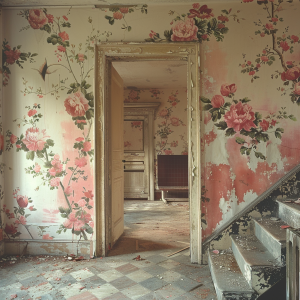

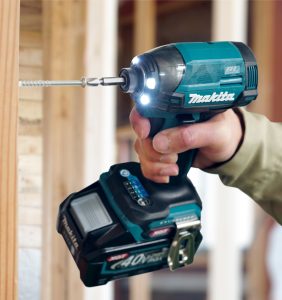




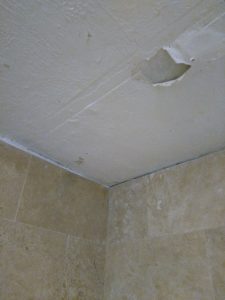
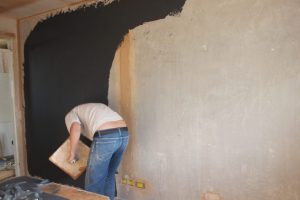
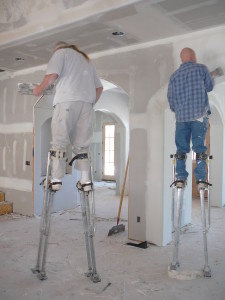
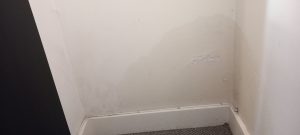
55 thoughts on “Painting New Plaster The Easy Way”
Some excellent advice there, we get asked these questions all the time, its nice to see a professional response which we can all use. It all helps give customer confidence when you take the time to explain the next steps.
Great advice and it’s nice to see good honest advice, as I am a decorator and paint a lot of new plaster I also get asked this question a lot.
Thanks 🙂
First-class advice. Some nonsense is spouted on this subject so it’s good to see a professional debunking the myths and offering clear, practical measures.
Thanks 🙂
I try and be as straight talking as possible 🙂
What sort of water/paint ratio should be used to dilute the paint for the mist layer?
Thanks
Hiya, I have been using 75% water recently but anything between that and 50% is good…. so my painter friends tell me :-\
Hi, great advice, would you use a different type of sealant on new plaster in kitchens when it is intended to use a kitchen/ bathroom paint? We’ve had to take our kitchen walls back to the plaster because the original, ordinary emulsion flaked off exactly as you described, and we intend to use kitchen paint in an effort to stop this happening again! Appreciate your time and advice thanks. Steve.
Hiya Steve,
In our bathroom and kitchen we have just replastered and painted and used normal emulsion… I am sure there are other alternatives but this has worked for me :-\
Hi, thank you for the advice above. I have a problem with a newly skimmed wall and I think I did all the things that youve advised to do. I waited for a few weeks until the plaster had dried and was the colour of the dry plaster shown above in the picture. I put 1 mist coat on which consisted of brilliant white matt emulsion (which is also the colour I am painting the wall) and water, waited for this to dry, and then painted my first coat of paint. After doing this I noticed a dark patch surrounding the middle of the wall which looked lighter. I thought this was just the plaster showing through so I applied another two coats but there is still the dark patch surrounding the middle of the wall. I really dont know why this is and have tried to find other cases similar online but haven’t been successful. Do you have any idea what this might be and how it can be rectified? Does it just need more coats of paint? I’d really appreciate your advice! thanks very much for your time. Holly.
Hi Holly,
that is very strange… was the wall damp there?
Head over to http://www.plasterersforum.com (our sister site) and post up some photos I am sure someone will be able to help and guide you through…
I have been painting my own place this week after replastering the whole lot and I have not seen this :-\
Danny
I painted over newly plastered walls with a silk emulsion 5 years ago. I have now painted the walls with a matt emulsion and the paint is peeling off the walls. Can you advise how I can fix this problem. When the walls were newly plastered the plasterer did not tell me to start with a mist coat of emulsion.
Hi there, I had a plaster and painter here. But apparently he wasnt very good. He advised us to buy silk paint and he diluted in water and pva for the first coat. The thing is there were some bubbles, there were some marks in the plaster which the paint wanst covering (so he applied undercoat paint for woods?). Now it seems fine, but I noticed that the paint gets easily off the wall up to the plaster. And it seems if u peel that, it will go all the way, like the paint is not adhered to the wall.
What you recommend us to do? Peel that all off and start over, with matt diluted in water for the first coat, and then 1 more coat of matt. and 1 or 2 of silk? We wanted silk finish to be wipable, so Im wondering when to apply as well.
If we dont rip off the whole paint do you think it will come off eventually and is just better to re-do the job now?
Should be the painter which was the plaster as well accountable for that, because of course he doesnt want to be.
oh blimey!!!
Well we have recently bought a property and it is very similar to your situation 🙁 We have peel all the paint of all of the walls and plastered and redecorated….
New plaster or even bare plaster needs to be sealed as the plaster sucks all the moisture out and the paint kinder sits on top. I am not a painter by trade so I would always recommend getting a professional painter in for the best advice 😀
Danny
Hi, new plaster should be aloud to dry properly, don’t rush to finish the job. A good mist coat is 10% pva 20% matt paint 70% water. The reason for this is that you need to water the paint to get into the plaster and bind any surface dust, this coat is not to cover the wall as a paint but to seal, the adding of pva is that when you water paint down to this extreme it changes the composition of the paint, and has no ability to bind as it is predominantly water with a stain, the stain is just to allow you to see were you are going. Do not use a vinyl paint as the media is more difficult to break down with water and will lump. You should add half the water slowly to the paint and half to the pva slowly so as to not go lumpy, one mixed mix them together, whilst using stir from time to time, as it will settle, allow this to dry for a couple of hours before putting on any other coats.
You should use Obliterating or New Work Emulsion. Never use Silk Emulsion on new stuff. Its also hard to cover and going to cost you more in the end! Make sure its dust free as well.
Thanks for that 🙂 Or do what I do and get a pro painter in 🙂 Thanks again for your comments 😀
Always use contract Matt emulsion on new plaster, not expensive to buy from any builders yard, good opacity don’t always have to dilute.
Contract Matt is vinyl free emusion, it’s the vinyl that causes the issues mentioned..
Vinyl Matt has small amount of vinyl in hence why they say it is “wipeable” to some degree.
Vinyl Silk has a high content of vinyl in and is fully “wipeable” and more hard waring.
Plastered my kitchen 2 weeks ago, looks pretty much dry (pale pink) now. Read before to wait 4 weeks to dry?! Would like to add a section of wall tiles for a hob splashback , and paint the rest Farrow and Ball modern emulsion. Do i mist coat the whole wall or just the area to be painted? Thanks.
I miss coated my whole wall 🙂 But leave bare plaster where the tiles are going if you can 🙂
Thank you… Do you think I should wait 4 weeks…Am at 2.5 weeks now…
Hi we’ve got some newly plastered highly polished walls in a bathroom which has dried out for 6 weeks; during which time the bathroom has not been used. I’ve read your advice about lightly sanding but wonder what grade of sandpaper we should use please? I’ve bought a hand sander but don’t want to spoil the finish by using too coarse a grade, and don’t want to risk peeling paint by using too fine a grade.
I bought a house and gutted the whole place and had it re plastered. I have painted the whole house top to bottom with Crown Emulsion Matt Brilliant White but I didn’t dilute the paint.
I’m slightly worried, so far I have had no issues and we’ve been living here with no carpets (First house) since November and we’ve had no issues.
What may come now or is the crown paint good enough as a mist coat? I did think it went on very thin, almost grey before it dried, I didn’t have any problems at the time and none since.
Advice would be greatly appreciated.
A true, tipical spread, that’s exactly what I say to my customers, knowledge handed down!
my plasterer finished 4 weeks ago, so the walls were definitely dry, my painter just put the paint on undiluted and there are blobs of paint all over the walls. He is of course blaming the plaster for a bad job, I don’t know who to believe. please can you advise, he has said he will rub the walls down and repaint in the morning, will this work?
sounds like the painter is a bit of chancer… the painter is there to make the job look great and if there is more prep there then that is that… hence a quote… without seeing the job in hand its hard to point a finger but any painter worth their weight should be able to overcome anything and will know that they need to water down the paint.
Ceiling plastered some weeks ago. Our professional decorator of whom I have great faith did the first cover using appropriate dilution only for the plaster to come off. The plasterer has returned and said it’s come off because of nicotine, before it was plastered it was a smoking house but has not been since, advice please. Plasterers only solution is to board the ceiling and start again. Is this correct. Advice desperately needed before we spend more money unnecessarily.Thank you
Hi Judi,
Yes nicotine is a common problem for plaster to fail on ceilings. I have in the past scrubbed walls and ceilings with a sugar soap solution to try and clean it off but it is a disgusting and horrible job to do. The best way is to overboard the ceiling and then reskim.
I am surprised that this was not offered to you at the time of the quote though. I would always give two options one would be skim it and if it stays up all good but if it fails it is down to the customer to pay to put it right or to overboard it which is a little more expensive but it will be fool proof solution.
Hi
Reading the above information which has been very useful so thank you.
I’ve painted my first mist coat on the advice of my plasterer using a vinyl Matt emulsion and 60% paint to 40% water.
He’s advised me to do a second mist coat but this time 80 – 20.
I finished my first mist coat about 4 hours ago and it seems completely dry already.
Do I need to do a second mist coat and if so how long should I wait to apply the second
Many thanks
Hello. I had a bathroom plastered 2 years ago, and last week I applied 2 layers of matt paint, as an undercoat and will follow this up with 2 coats of bathroom paint. A relative came over and said I should have sealed with PVA and thin paint, and now I’m worried it’ll make a mess in the future as I’ve not. As there anything I can do to rectify this?
I have never used PVA and then painted and none of the painters who have painted my own properties have used PVA…
Thanks for your reply. I’m just going to go over the matt with bathroom paint and hopefully that should do the trick!
Hi this really helped thank you
but any one know what to do for wallpaper
To much different information on net and cas this is my first house first timer am confused
My room is plastered n now its dryed been a week n I painted all the walls half water n half paint mixed
now i want to wallpaper over 2 walls what do i do n how
Thanks
I have never wallpapered in my life… it may be worth asking over at http://www.plasterersforum.com
Ive painted silk paint straight onto new plaster and it’s gone patchy need to now if I can put matt over it
I have taken down wallpaper off plastered walls and will paint. I’m sure the paper had been on there a long time. Therefore, the plaster is not new. How do I prime the walls? Is a mist coat still needed or can I use a primer/sealer like Zinsser 1-2-3 or Kilz water based.
I would clean the walls with a sugar soap to get any of the wallpaper adhesive off and then use a mist coat as above 😀 I would like to point out I am not a decorator though 😀
Hi there. You mentioned that draughts and heating can affect the drying time of plaster. What’s the best way to speed up the process? Think I read somewhere that cold and ventilated is better than warm, enclosed air, but that may be wrong!
Yeah open a window and a dehumidifier 😀
Hi there. I have mist coated new plaster (which had dried) with two coats of silk emulsion (50/50 water to paint). I know I should have used matt but what should I do now? Continue with an overcoat of silk paint or sand all the walls and ceiling back?
I’m kicking myself!
Hey, We had our walls re-plastered 6 weeks ago. Me and my partner had agreed to start painting this weekend and i had planned to start with a mist coat. However my partner surprised me by painting half the room with normal matt white whilst i was at work. I am concerned, will this peal off is there anything i can do to rectify this and should i continue with the 100% paint for the rest of the room or dilute it and do the mist coat.
hi, i have recently had the full house boarded and plastered and it seemed like a good job untill i came to painting. after apllying the mist coat, there seems alot of blemishes, scratches etc. it is especially bad in some light. what can i do ?
Hiya bthe only thing you can do is sand and fill and be a little ocd with it…
Just thought I’d mention I always sand new plaster once it’s dry – then fill any blemishes (scratches dinks I’m able to see)- Filling is done not with filler but with Wicks ready mixed skim plaster – comes in I think 5 and 10 litre tubs. Then do a mist coat of probably around 3 parts cheapest matt white paint I can find to 2 of water, then go over and fill any remaining dinks with more skim plaster (I use that flexible filling knife again) – Then do a quick mist coat over the bits just filled and once dry either paint or wall paper.
The Wickes skim plaster is good for filling dinks in a painted wall, sand and feather in to the paint and then paint the area with whatever tool you originally painted with. I always use a mini roller on everything – it might take longer but – it gives a better finish, is lighter to hold (for ceilings especially), less splattering, is easier to clean and I think you waste less paint.
I’ve just de-artexed the final room in our house (have done 7!) using a steamer and scrapeing off with a flexible filling knife – took 80 hrs and is messy – and it’s left some of the surface finish quite bad in including some of the paint that was under neath with scratches in it. The Wickes skim plaster has worked a treat over those and just on the point of doing the first mist coat.
Also I removed over 150 proud of the surface rawl plugs that were under the artex. I under filled the holes with Wickes powered interior filler and then used the skim plaster once that was dry and sanded to a smooth finish – it’s incredibly easy to hand sand and gives a lovely finish (I have no affilliation with Wickes by the way!)
One more tip – I find the easiest way to find blemishes (especially on unpainted plaster) is to use your finger tips to go over the wall. You will find things you never see with your eye until it’s painted. :0)
Hi
Just had the kitchen and dinner walls and celings all skimmed and it is now almost dry and ready for painting. So beacsue it is a kitchen area do I still just use a cheap matt paint diluted to 75% paint and 25% water as the mist coat? Or another ratio of paint to water? Then what type of paint would |I be best to use as the main coats. I am thinking beacsue it is a kitchen do I need to use a vinly silk or something similar?
Waiting until the plaster is dry to start painting is a good idea. If you wait, that will enable the paint to adhere to the wall better making giving it a more professional complete look. If you are working with a plaster company, making sure that they don’t leave until the plaster has been fixed of issues would be helpful.
Hi,
I boarded out our bedroom with thermal plasterboard and the skim coat was finished 10 days ago. Was well ventilated for the 10 days and we we convinced it was dry. We just did the first 2 coats with specific new plaster paint by wickes. No problems with flaking or bubbling etc but an area in the angle between wall and ceiling maybe half square metre in size is slightly discoloured, slightly yellow. Is it wrong to cover this with zinesser bin white primer and undercoat to hide it? Strange as the whole rest of the room is fine thus far.
Hi just had my lounge skimmed walls and ceiling. The walls were great but the ceiling however seemed ok until
I painted it .. some areas have come up nice but in patches it looks bumpy .. any suggestions on how to get these bumpy marks out my ceiling sand it back then re paint or re skim ?
Hiya
Right get a sanding block and and some filler… using a sanding block will give you a good chance at getting it flat… if it is really bumpy then get the plasterer back and see what they can do… A reskim may be an option but without seeing it its hard to say for sure. 😀 A reskim is however just that, it goes on about 3mm thick so it can only do so much 😀
Hi, I’ve just painted my new plaster with a 4:1 mix of paint and water only to realise what I thought was emulsion was in fact satin wood! Is this going to cause a problem as it was watered down? If so, what can I do to remedy it? Thanks
Hi. I have just started painting newly plastered walls in our new build home and though the plasterer has done a fabulous job, I realise now , reading the advice on here, that the walls are too highly polished in places and as a consequence , I imagine, the watered down first coat of paint is simply not adhering properly in various random sections. Should I lightly sand the walls in between first and second coat ? Thanks.
Honestly if I was unsure I would be sanding back to the plaster and then starting again…. or just suck it and see how it goes 😀
Can anyone advise?
New plaster had a minimum of 2 weeks drying, plasterer said ready to paint. Crown Matt paint was watered down, 2 mist coats applied. The walls are dusty -is that paint or some kind of reaction to the plaster? I have wiped with a damp cloth and in places it goes almost to bare plaster!
Any ideas for next step Please!
Hiya that sounds like the paint. We have wiped walls down at home and taken the paint back to plaster